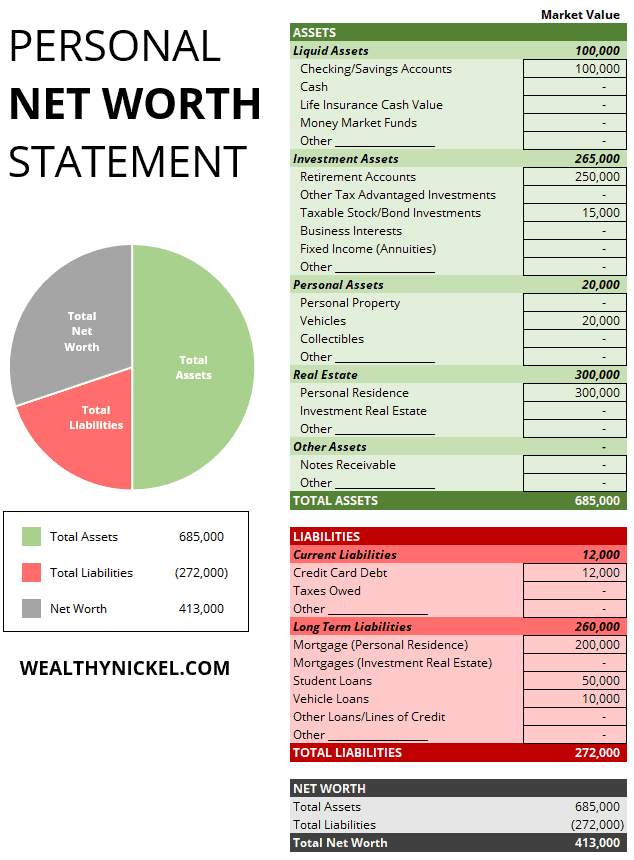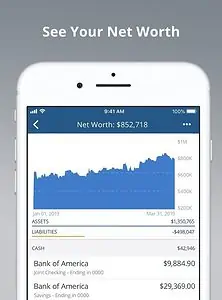

That was what the loan officer said, as if it was the most obvious thing in the world. It was the first time we were trying to get a loan at a local bank for a property my wife and I were planning to fix up and sell.
I panicked a little bit – what was a personal net worth statement? How was I going to come up with that?! Until then, our bank records were a little bit of a mess.
Fortunately with a little bit of work (and a lot of combing through bank statements), we were able to put together our personal financial statement and get the loan we needed to buy the house.
At the end of the day, a personal net worth statement is not as scary as it sounds. I actually think everyone should have one. Since then it has helped us get a clearer picture of our finances and make the best decisions to increase our net worth and accelerate our path to financial freedom!
Table of Contents
A personal net worth statement or personal financial statement is simply your personal balance sheet. If you were a business, what would you be worth? Add up the value of all your assets (what you own), and subtract the value of your liabilities (what you owe), and that is your net worth.
Here is the simple personal net worth formula:
Assets (What You Own) – Liabilities (What You Owe) = Personal Net Worth
A personal net worth statement helps you document and categorize your assets and liabilities so you can always have a running total of your net worth.
Often times you will need this if you are looking to take out a loan or line of credit from a bank, as they want to know that if things go south, you have enough assets to pay back the loan.
But tracking your net worth is also the best way to get an overall picture of your financial health.

Click the link above to get your own editable version of the Personal Net Worth Statement in Excel (XLS) and start tracking your net worth today!
I mentioned before that I recommend that everyone should have a personal net worth statement. It is an important personal finance tool in your toolbox.
Here are several reasons you should have a net worth statement for yourself or your family:
I would be remiss if I didn’t mention one of my favorite tools that I use to keep track of my net worth in real time – Personal Capital .

I use Personal Capital to link to all my accounts so it’s all in one place. One of the most time-consuming things about tracking your net worth is logging into each and every bank account, mortgage account, 401(k) account, etc. every month to record your balances.
You can link you accounts once to Personal Capital, and have them automatically refresh. It saves me a ton of time every month over manually checking each account.
There are also many other free features, such as budget tracking, portfolio analysis, and retirement calculators.
One thing to note – they do offer paid investment management services if you have a certain amount of money in your investment accounts. However, I have always only used the free features and been very happy with the app.
I still dutifully transfer everything to my net worth tracking spreadsheet (because I’m a nerd like that), but Personal Capital has been a great addition to my personal finance tool set.
Personal Capital helps me keep track of my net worth without having to worry about logging into 37 different accounts (ok maybe a slight exaggeration, but not much) to add up all my balances.
If you’re looking for a single app to help you keep track of your income, expenses, net worth, and investment accounts, I highly recommend giving it a try. It even helps you optimize your portfolio’s asset allocation and shows you where you can save on fees.
Writing a personal net worth statement is as simple as listing all of your personal assets and liabilities.
Of course, depending on how complicated your finances are “simple” doesn’t necessarily mean “easy”. After we started investing in real estate , our financial picture got a lot more complicated. We had multiple rental houses along with multiple mortgages, and multiple bank accounts set up.
Determining the value of your 401(k) is as easy as looking at your most recent statement and recording the dollar figure. But determining the value of the rental house you bought 3 years ago is a little bit trickier. If you don’t have a recent appraisal, you have to resort to using your judgment or that of a real estate professional to determine a reasonable value.
Below are the categories you should consider when setting up your personal net worth statement. I can’t say this is an exhaustive list, but the goal is help you think through everything you own and everything you owe to get an accurate picture of your net worth.

Click the link above to get your own editable version of the Personal Net Worth Statement in Excel (XLS) and start tracking your net worth today!
Liquid assets include cash or anything that could quickly be converted to cash without losing value. Often banks will want you to have sufficient liquid assets to cover expenses for a certain period of time. Knowing your liquid assets can also help you calculate your liquid net worth.
Most people have investments of some kind whether through retirement accounts or other stock/bond holdings. But you can invest in all kinds of things such as businesses, or your friends awesome app he developed that he promises will make a ton of money!
Personal assets include anything you own of value for everyday household use, or other non-investment assets.
If you own your home or other investment real estate, you’d estimate that value here. You may need to enlist the help of a professional real estate agent or appraiser to get an accurate value. I would never personally recommend Zillow’s valuation algorithm, but if you are just keeping track for your personal records I suppose you could use the Zestimate.
Any other assets not accounted for elsewhere.
Current liabilities are generally those that are due within one year (hence “current”). So things like credit cards or short term loans.
Long term liabilities are those that loans that you owe further out in the future, such as a 30-year mortgage or student loan debt.
Your net worth is calculated by taking your total assets minus your total liabilities. If you’ve documented everything above, it should be pretty simple math.
Net Worth = Assets – Liabilities
The first time you calculate your net worth, you might be in for a surprise. If you’ve only relied on your bank account balance to tell you how wealthy you feel, seeing your true net worth can come as a shock – either good or bad.

The benefit of having a personal net worth statement is not in what the actual number comes out to be.
The true power is in having an awareness of your total financial picture, and then tracking over time to make sure you’re going in the right direction.
For example, if you’re in your mid-20s, recently graduated with student loan debt and no real assets to speak of, you could have a negative net worth. As an over-simplification, if you have $50,000 in student loans and $5,000 in the bank, then your net worth is negative $45,000.
But that number by itself doesn’t tell you much. Sure you are starting in the hole, but you have your entire career ahead of you with opportunities to increase your earnings.
As you start to track your personal net worth statement over time, you should see it move in a positive direction. And by seeing the details behind your assets and liabilities, it will help you make better decisions with your finances.
Seeing that number go up can inspire you to find ways to save more money, or make extra money through a side hustle, to keep it headed in the right direction.
When we first started investing in real estate, I was shocked at how quickly our net worth grew. We always aimed to buy a house at a maximum of 80% of market value, fix it up, and rent it out. Each house we purchased added an instant $20-$30,000 to our net worth because of the “sweat equity” we added. As they say, in real estate you make your money when you buy. That has definitely turned out to be true for us.
In the same way, by tracking your own personal net worth statement, you should be able to recognize the patterns and see where you should focus your efforts to continue to build wealth on the path to financial freedom.
If you made it all the way to the end of this article, you’re obviously interested in tracking and growing your net worth. If so, I highly recommend you check out Personal Capital. Their free app is the easiest way I know to see all your accounts in one place and get a snapshot of your financial health anytime you want.
Do you maintain a personal net worth statement? Let me know in the comments!